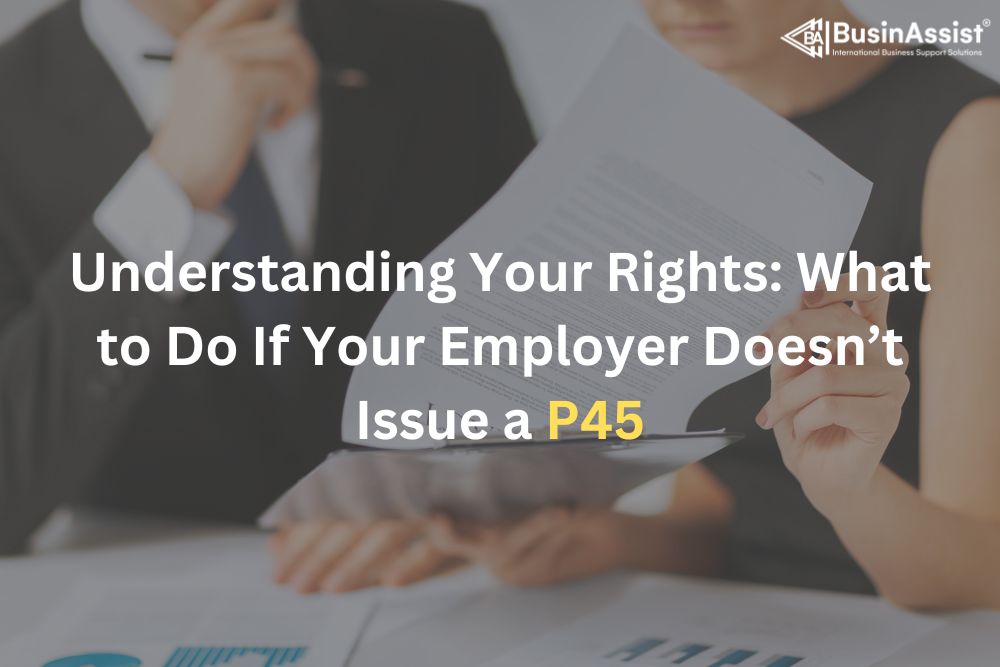Last Updated on September 4, 2025 by Joy Kyalo

UK company formation for just £0.99 and get your UK virtual office address for only £0.88 – available for both UK and non-UK residents!
When you leave a job for a new one, retire, have redundancy, or are sacked for other reasons, your employer must issue a P45. A P45 is a form that lays out your income and the tax an employee has paid for the current tax year.
According to the Income Tax (Pay As You Earn) Act 2003, the employer is obligated to provide P45 to the employee on the last day of employment without delay. The new employer uses this form to see taxes paid in the current year making it easier for them to know which tax code to place you on.
But what happens if you don’t give your new employer your P45? Here is a quick guide to help you know everything about P45.
Key Takeaways
- Employers are legally obligated to issue a P45 on your last working day, and you have the right to request it if not provided.
- If your previous employer refuses, HMRC can intervene, and the employer may face compliance investigations or penalties.
- Without a P45, your new employer will put you on an emergency tax code, which could mean paying higher taxes until corrected.
What is P45?
This is a document your former employer gives you when you leave a job in the UK. It lays out the employee’s income and the tax they paid during the current tax year (6 April 2024 to 5 April 2025). P45 form helps your new employer determine the correct tax code for you, ensuring you don’t overpay or underpay taxes. It is the responsibility of your previous employer to issue a P45 on the last day of employment.
It comes in 4 parts. Part 1, your previous employer sent it to HM Revenue and Customs (HMRC), 1A is the employee’s part to keep for reference, and parts 2 and 3 go to your new employer or job center if you are looking for employment.
If you are not employed during the current tax year or you are retiring, you can use P45 to claim the tax benefits you are entitled to.
The form is only valid for the current tax year. This means, if you were unemployed during the tax year, P45 will be invalid and your new employer will have to submit other documents to HMRC to calculate your tax code.
What is P45 used for?
Updates HMRC: When your previous employer sends you a P45, they also send the 1st part to HMRC to inform them of the change in employment.
Provide information to new employers: When employees switch jobs, P45 is given to new employers to know which tax code to place them on. Without a tax code, an employee risks being placed on an emergency tax code meaning you will pay higher taxes. The new employer will be able to access the employee’s tax code, previous employer details, gross pay, and the tax paid during the current tax year.
Calculate final payments: P45 is filled by the employer and used to calculate the employee’s final payments.
Claim benefits: Employees can use the P45 to claim any benefits they are entitled to.
Enable ex-employees to claim tax refunds: Ex-employees can use P45 to access certain benefits and tax refunds.
Essentially, P45 provides HMRC, new employer, and employee an overview of a person’s earnings and tax paid during the tax year, thereby playing a vital role in both financial documentation and legal requirements within the UK employment framework.
How do I get a P45?
It is a legal obligation of the former employer to provide the employees with a P45 document without any delay. There is no time frame as to when they should issue the form, however, they are expected to issue it on the last day of the employment or payday.
Should the former employer neglect to issue P45, the employee can make a formal request. If the form is still withheld, the employer has a right to ask for a “statement of earnings.”
However, if they continue to refuse to provide you with the form, the best course of action would be to contact HMRC since they offer help on such matters. If your P45 is misplaced, regrettably, a replacement cannot be issued. Your new employer is required to complete a “starter checklist” to obtain your necessary information.
What to do if your employer doesn’t issue a P45?

Employers should provide you with P45 when you leave employment. However, employees may not be aware of the circumstances in which they should receive P45 documents. This document is not a reward for you when leaving a job, but a legal document when leaving the job. It is not only given to employees who are leaving for another job but also to employees who are retiring or fired due to other reasons.
When your previous employer doesn’t issue a P45, you can;
Request from your previous employer:
It is your right to ask for the P45 document from your previous employer. You can either contact them by phone or email and firmly give them a deadline to issue it.
Do not forget to mention that you will contact HMRC if they fail to issue the P45 within the deadline given.
Contact HMRC:
If you contact your former employer and still don’t provide you with the P45 documents within the stipulated time frame you gave them, contact HMRC to report the issue. HMRC will contact your previous employer to address the issue.
Pro Tip: Don’t Delay if You Haven’t Received Your P45
If your employer doesn’t issue your P45, act quickly – first request it directly and give a clear deadline. If they ignore your request, escalate the matter to HMRC, who can enforce compliance and even penalize the employer. Remember, without a P45, your new employer must put you on an emergency tax code, which could mean paying more tax than necessary.
If they fail to send you the P45 form once HMRC has communicated with them, they can face legal action. The action can take different forms such as Employer Compliance Investigation which is stipulated to look at PAYE and National Insurance requirements. This action can be costly and may be fined in the process.
After the rigorous investigation, if your previous employer does not issue the P45, what happens if you don’t give your new employer the P45? Your employer will need to generate an emergency tax code for you.
What happens if you don’t give your new employer your P45?
Employees can start a new position even if they do not have a P45 document. Instances where an employee starts a new position without a P45 are if the former employer did not issue it or the employee was unemployed within the previous tax year. If you do not offer your new employer with P45;
- They will generate an emergency tax code for you
- Work out how much taxes you should pay on your salary
- Have you filled out a starter checklist to determine your tax code
What happens if you don’t give your new employer your p45? If you do not give your new employer your P45, you will be placed on an emergency tax code where you might pay higher taxes. Your new employer will also have to send some documents to HMRC to place you in a tax code. However, it is important to make sure you have your P45 as soon as you leave your previous employment.
P45 document is not only offered when you are switching jobs but also when you want to retire, be sacked, or redundancy. As an employee, you should understand the circumstances under which your former employer has to issue you with P45. You can use the document to switch jobs, claim benefits, and tax refunds.
At BusinAssist, we help with UK-limited companies’ tax filings. We help businesses remain tax-compliant by filing corporation tax returns, confirmation statements, and VAT returns. We also offer VAT number registration services to businesses that have reached the VAT tax threshold which is £90,000 or want to register voluntarily.
For more information on tax obligations, contact us at info@businassist.com.
FAQs
Q: How long does an employer have to issue a p45?
Ans: There is no legal time frame for employers to issue P45, however, they are legally obligated to issue the document to the employee on the last day of their employment or their last payday.
Q: When should an employer issue a p45?
Ans: The employer should issue a p45 document on the last day of employment or payday.
Q: How quickly should an employer issue a p45?
Ans: According to the Income Tax (Pay as You Earn) Act 2003, the employer should issue P45 immediately on the last day of employment without “unreasonable delay”.
Q: How to get a p45 from a previous employer?
Ans: It is the legal responsibility of the former employer to issue P45. However, if they don’t, the employee can firmly ask for it. If they do not issue it after you ask for it, you can communicate with HMRC to address the issue.
Q: Does my new employer need my p45?
Ans: Yes, your new employer needs your P45 document to know the tax code and where to place you. They will also access your previous gross salary and employer details.
Read Also:
- The Process of Porting Landline Numbers to VoIP: What Every UK Business Should Know
- Registered Office Address in London, UK: A Guide for Your Business Needs
- Can HMRC Access Your Bank Account? What Every Taxpayer Should Know
- What is an SA401 Form and How to Submit It to HMRC: A Complete Guide
- What is a Tax Office Reference Number and How Can I Find It?
- How to Change Your SIC Code on Companies House: A Step-by-Step Guide for UK Businesses
- Lost Your Government Gateway User ID and Password? Here’s How to Find Them
- How to Fill Out a Stock Transfer Form J30: A Step-by-Step Guide
- What are Redeemable Shares and How Do They Work?
- Do Private Individuals Need an EORI Number? How to Get One Explained

Joy is a content writer at BusinAssist with 6+ years of experience in content marketing and social media strategy. She specialises in company formation and virtual operations, guiding entrepreneurs through global markets with clarity, drawing on her marketing and PR background. Business Assist with BusinAssist – your business success partner.

